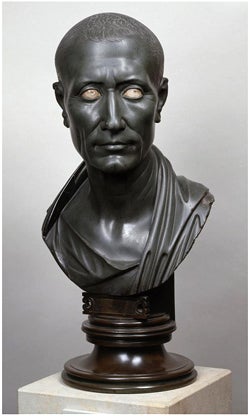On this day: The Ides of March

Master of the Apollini Sacrum | The Assassination of Julius Caesar, 1475-1500 | Spencer Museum of Art, University of Kansas | Image and original data provided by the Samuel H. Kress Foundation

Roman | Bust of Julius Caesar, mid 1st century BCE | Image and original data provided by Staatliche Museen zu Berlin, Stiftung Preussischer Kulturbesitz
Julius Caesar, “dictator in perpetuity” of the Roman Empire, was murdered by his own senators on the Ides of March (March 15), 44 BC. Caesar had raised the ire of his already-resentful Republican senators after he appointed loyal members of his army to rule the Empire while he was away from Rome to fight in a war. Cassius Longinus started the plot against the dictator and was joined by his brother-in-law Marcus Brutus, Caesar’s protégé. As depicted in this painting from the 15th century, Caesar was stabbed to death by the entire group of senators after being lured to a senate meeting. To their surprise, they did not find support from the populace, and the houses of Brutus and Cassius were attacked. Both of them committed suicide two years later after their forces were defeated by Caesar’s adopted son Octavian. The painting of Caesar’s murder comes to us from the Samuel H. Kress Foundation collection, and the bust of Caesar from the Classical Sculptures (Berlin State Museums).
Search for Julius Caesar for more images of the emperor, and for Brutus to find images of the murderer, as well as images from a manuscript of Cicero’s “Letters to Brutus, Quintus, Octavian, and Atticus” from the Manuscripts and Early Printed Books (Bodleian Library, University of Oxford).
Archaeologists believe they have found the exact place where Julius Caesar was stabbed; search for Largo di Torre Argentina to see photographs of the site from the European Architecture and Sculpture (Sara N. James) collection.